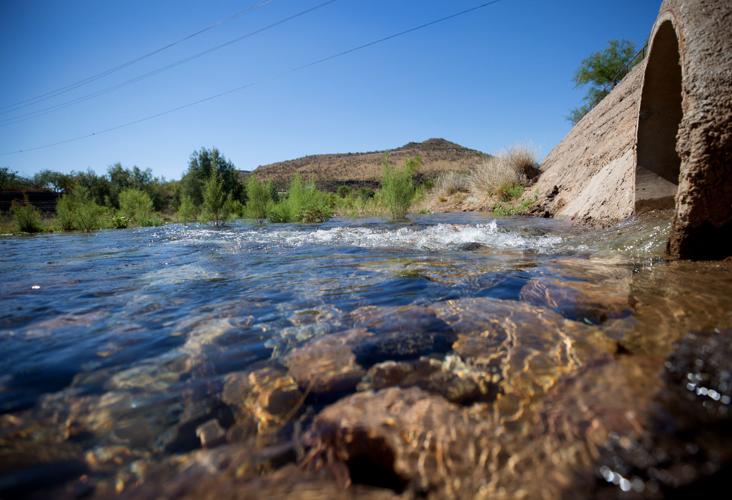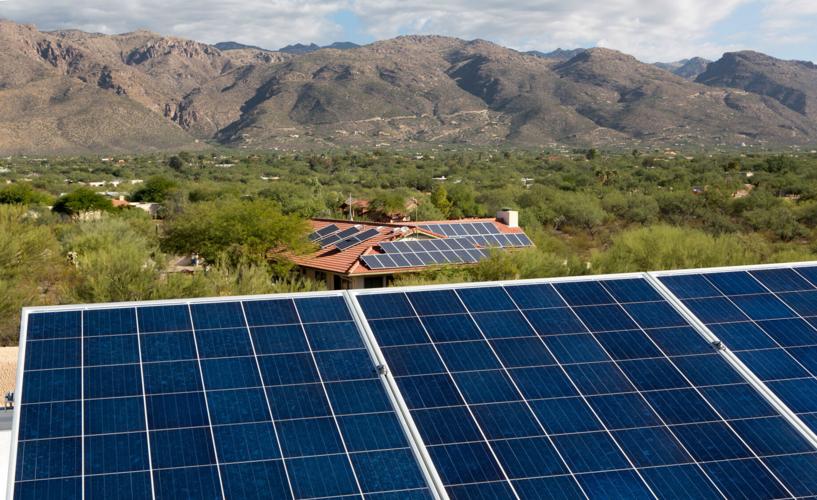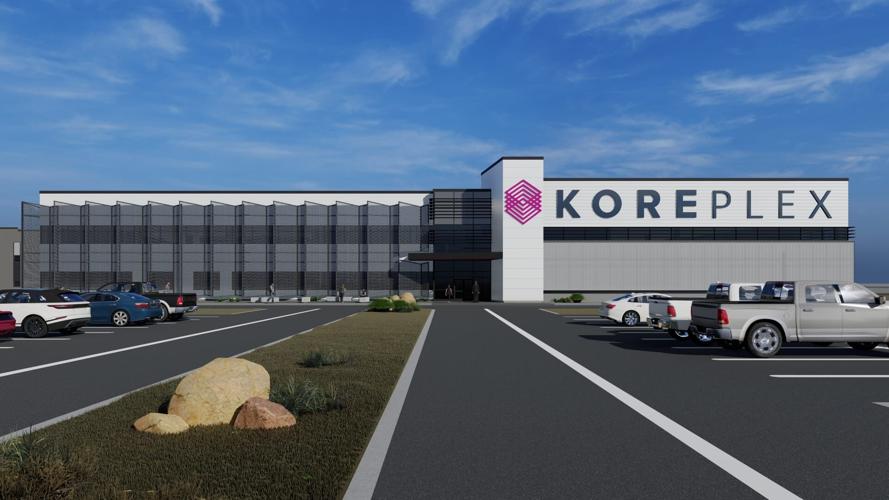In Tucson, the federal payout for buying new low- and zero-emission buses and for conserving Colorado River water over the next few years approaches $100 million.
A new battery factory south of Tucson International Airport is slated to reap more than $1 billion in private investment by the time it goes online in 2025 or 2026.
And in the coming months, millions or tens of millions more in federal dollars could pour into Tucson city government for tree planting and solar panels. The spending would be concentrated in lower-income, inner-city neighborhoods that have been documented to have worse heat and less shade than more affluent parts of the metro area.
Statewide, the influx of federal payouts and private capital for clean energy projects and water projects has been and will continue to be far more expansive. Total expenditures of that nature in Arizona have reached or exceeded $10 billion since passage of two major investment laws in 2021 and 2022 — the Bipartisan Infrastructure Law and the Inflation Reduction Act, respectively.
That doesn’t include what is expected to be a huge amount of federal tax credits granted under these acts for individuals to buy electric vehicles, solar panels and the like.
Nearly $2 billion has come to Arizona in federal subsidies for various clean energy programs and projects.
Consumers, particularly those with lower than average incomes, will be able to apply for state-awarded rebates, totaling more than $150 million, for buying heat pumps, heat pump water heaters and electric stoves, and for energy saving home retrofitting projects. The state expects to start giving them out in early 2024 at the latest.
Arizona will also get $76 million to build electric vehicle charging stations and other infrastructure, and $75 million for planning and projects to reduce the risks to communities from natural disasters, including floods and wildfires. Another $47 million is coming to Arizona to pay for individual home weatherization projects, including insulation, caulking, weather-stripping and modifications to furnaces to make them more energy-efficient.
In all, more than 50 grants, ranging from $7,000 to $75 million, have gone to state and local government agencies, private businesses, tribes, universities, airports, and nonprofit groups for various programs and projects.
When it comes to private investments, three major battery manufacturing plants are planned for Arizona, including the American Battery Factory plant in the Tucson area.

Tucson Mayor Regina Romero, left, during a Tucson Million Trees planting event in 2020. The city hopes to get $7 million in federal funding for the project, which advocates say helps fight climate change because trees remove carbon dioxide from the air and provide shade.
Overall, the clean energy advocacy group Clean Power lists plans in the works for 13 new private “clean power” projects in Arizona, at a total investment of $8.3 billion that will bring more than 12,000 jobs.
Spending advocates, critics
Nationally, plans for nearly 80 major clean energy manufacturing facilities have been announced since passage of the Inflation Reduction Act. That’s an investment equal to the previous seven years combined, the Associated Press has reported, citing the American Clean Power Association.
The Inflation Reduction Act is America’s most significant response to climate change, after decades of lobbying by oil, gas and coal interests stalled action, while carbon emissions climbed, creating a hotter, more dangerous world, the AP reported. It is designed to spur clean energy buildout on a scale that will bend the arc of U.S. greenhouse gas emissions. It also aims to build domestic supply chains to reverse China’s and other nations’ early domination of this sector.
For environmental activists and like-minded local, state and federal officials from Arizona, these investments are cause for celebration. Celebrate they have in the past week, holding press conferences and cranking out news releases to proclaim their gratitude for the federal help.
They’re particularly thrilled about the Inflation Reduction Act, signed into law on Aug. 16, 2022. The Biden administration expects it to pour at least $369 billion nationwide into direct subsidies and tax credits for solar installations, electric vehicles, energy-saving appliances, battery manufacturing and a long list of others programs and projects. Overall, the act is expected to cost $1.2 trillion, including federal payouts and loans for other programs and projects.
Outside experts such as Goldman Sachs say the tax credits in particular will draw far more interest at much greater federal expense than anticipated, and that the Inflation Reduction Act will trigger $3 trillion in private sector investments nationally over 10 years.

The Central Arizona Project canal near Sandario Road and Mile Wide Road northwest of Tucson. Tucson is getting federal compensation for leaving some of its CAP water supply in dramatically shrinking Lake Mead.
The act and other grants the Biden administration has pushed for are “helping Tucson take quick and clear action based on funds available to cities like we have never before seen, to insure climate resilience,” Tucson Mayor Regina Romero said at a news conference Wednesday, the anniversary of the act’s signing.
The advocates say the act is an essential first step toward weaning the country off what they see as a century-long addiction to fossil fuels and the heat-trapping greenhouse gases they create. The act was a beginning — “a transition point” — towards a future society with renewable energy and clean air and water, U.S. Rep. Raúl Grijalva, a Tucson Democrat, said at the news conference.
President Biden has backed off from his year-old claim that this act would make a significant dent in inflation — most economists agree it’s hasn’t. But he and other backers say the programs funded by the act are nothing less than the start of a revolution for a sustainable society.
But Republicans and conservative commentators say the programs are corporate welfare, wasteful tax giveaways to affluent people and economically counterproductive. They continue to push for measures in Congress to strip much of the act’s funding, with little success to date.
Some critics of the act remain skeptical about the severity of human-caused warming and other climate changes. Others say that even the private investments into battery factories and solar panel manufacturing will “crowd out” financing that would otherwise find its way into other projects, including those for fossil fuels, that have historically drawn more private investment.

In the coming months, millions or tens of millions more in federal dollars could pour into Tucson city government for tree planting and solar panels. The spending would be concentrated in lower-income, inner-city neighborhoods.
To mark the anniversary of the act’s passage, Republicans on the Senate Environment and Public Works Committee graded the act an F and called it a “reckless spending spree.”
Tucson water conservation
For Tucson, the most immediate gain from the act is federal compensation for leaving some of its annual Central Arizona Project water supply in Lake Mead to prop up the lake that’s been dramatically shrunk by 23 years of drought.
“First and foremost, in order to be able to thrive as a sustainable desert city, we need water, and since the city and our residents have long had a conservation ethic in terms of water, we took advantage of the IRA” to get money to conserve water, Tucson Mayor Romero said.

Reclaimed water coming into the Santa Cruz River. Tucson will spend $44 million on "system conservation" of water. Mayor Regina Romero wants the spending to include expanding the city's reclaimed water delivery system and cleaning up groundwater tainted with PFAS compounds.
Tucson will spend its $44 million on "system conservation" of water. The mayor says she wants to expand the city's reclaimed water delivery system and to cleanup groundwater tainted with PFAS compounds.
The city has agreed to leave up to 110,000 acre-feet in Lake Mead over three years ending in 2026. Normally, it gets 144,191 acre-feet a year. In return, the U.S. Bureau of Reclamation will pay the city $400 an acre-foot. The water to be saved is about 25% of the city’s total CAP supply over the three years.
The bureau has agreed to make similar payments to six other Arizona cities and to mining giant Asarco. They and Tucson will leave a total of nearly 400,000 acre-feet in the lake over three years in return for $157 million in U.S. compensation. In addition, the Gila River Indian Community will leave up to 125,000 acre-feet a year in Lake Mead for three years — more than one-third of its total CAP supply — in return for up to $150 million in compensation.
Besides these payouts, the act will ultimately supply $4 billion for drought relief efforts throughout the West — money obtained due to intense lobbying by Arizona’s two senators and those from other Southwestern states.
Tucson will spend its $44 million on “system conservation” of water, “to make sure we really continue cutting our use of Colorado River water,” Romero said.
The City Council hasn’t decided how it wants to spend the money and Tucson Water has yet to weigh in. The mayor told the Star on Thursday that she wants the money to go for expanding the city’s reclaimed water delivery system, along with cleanup of groundwater that’s tainted with PFAS compounds. She would like this issue to be discussed at a City Council meeting in the second half of September.
If the reclaimed system is expanded, that water could replace the use of potable water on grass in schools and parks.
“There’s still a lot of reclaimed water out there that we have ability to utilize, but we don’t have infrastructure in place to reuse it,” Romero said. “We have to make sure we reuse every single drop of it, either for schools or parks that don’t have access to it, or economic development centers that don’t have access to it.”
Tucson has also received $48 million in recent years to buy electric buses and compressed natural gas buses, using federal funding from the 2021 infrastructure act.
Million Trees program
Next on the city’s wish list for Inflation Reduction Act money is its pending grant application for $7 million over five years to buy and plant native, low water-use trees, as part of Romero’s program to plant a million trees in the city by 2030.
Officials don’t know how many trees that much money will allow them to plant. But Romero said it could add “tens of thousands” to the more than 100,000 trees planted since the city program started shortly after she became mayor in December 2019.
One reason it’s hard to estimate how many trees could be planted is that the city’s approach with the $7 million grant, if it’s awarded, “is not only to plant the trees but to plant the water,” said Katie Gannon, executive director of Tucson Clean and Beautiful, a nonprofit group partnering with the city on the grant application.
Especially now, with Colorado River shortages in the picture, “we are looking to harvest rainwater to sustain those trees for the long term,” Gannon said. Some of the money will also be used for “engaging and incorporating the community into the planting — you can’t just drop trees into the ground. You need folks to take care of them,” she said. “We don’t want to just plant a million trees — we want to grow a million trees.”
If the city gets the grant, it will focus also on “workforce development,” Romero said. It will use some of the money to hire young people to be “tree leaders” and to train people to fill six certified arborist positions, she said. The trees will be planted in the city’s most vulnerable neighborhoods, those with the hottest temperatures and the least tree canopy, she and Gannon said.
“For some time, I’ve been talking about trees as a nature based solution to climate change — not the entire solution, but one part of piece of the puzzle,” Romero said. Trees remove carbon dioxide from the air as well as providing shade.
Tucson also plans to join Arizona government in seeking funds under a $7 billion federal program called Solar for All, Romero said. The U.S. Environmental Protection Agency is soliciting applications for the program.
The program’s purpose is “to expand the number of low-income and disadvantaged communities primed for residential solar investment —enabling millions of low-income households to access affordable, resilient, and clean solar energy,” EPA said in June.
“I don’t think city can go at it alone. We need to partner with the Governor’s Office, to go after a big chunk,” Romero said.
Battery factory jobs
The American Battery Factory manufacturing plant is now planned for an area south of Tucson International Airport.
The Tucson plant is slated for a $1.2 billion investment and is scheduled to hire 1,000 workers when it opens in 2024 or 2025.
American Battery Factory, a spinoff of energy-storage systems maker Lion Energy, plans to produce lithium-iron-phosphate battery cells for home and commercial energy-storage systems at Pima County’s Aerospace Research Campus.
Under a lease-purchase agreement Pima County supervisors approved in December, American Battery Factory would lease up to 267 acres of land, south of Raytheon Missile Systems, at fair market value as determined by an appraisal.
The company announced plans to build the Tucson factory shortly after passage of the Inflation Reduction Act, which will offer two kinds of tax breaks for battery manufacturers. The project would have penciled out without the tax breaks, and would have been planned if the act hadn’t passed, company officials said.
But Zhenfang “Jim” Ge, CEO of American Battery Factory and chairman of Lion Energy, said both companies plan to take advantage of the IRA tax breaks and said they will be “very helpful.”
American Battery Factory will seek a tax break of $35 per kilowatt hour per battery cell produced, and Lion Energy will seek a $10 per kilowatt hour tax break that can be used by a battery pack plant, Ge said.
A second battery factory is targeted for Buckeye west of Phoenix. Kore Power, of Coure D’Alene, Idaho, plans to open in late 2024 or 2025 a lithium-ion battery cell manufacturing facility to build batteries for electric vehicles and energy storage systems. It will invest $1.25 billion to build the plant and create about 1,250 permanent jobs to build close to 60 million battery cells annually, it has said.
It’s gotten federal help in the form of a U.S. Department of Energy conditional approval for an $850 million loan under DOE’s Advanced Technology Vehicles Manufacturing Loan Program, established by the 2021 infrastructure law.
While plans for the factory were underway before the Inflation Reduction act passed, “it is difficult to overstate the importance” of the act for clean energy component manufacturing in the U.S., said Aleysha Newton, a company spokeswoman.
The act gave Kore Power an “incredible lift,” triggering an increase in demand for domestically produced battery cells, company officials have said.

KORE Power, building a battery factory in Buckeye, is one of three companies bringing major battery factory projects to Tucson. One such project is coming to Tucson.
“For the first time American (clean energy) manufacturers are on an even playing field with manufacturers in other parts of the world that have been heavily subsidized,” Newton said.
“Additionally, the IRA also leveled the playing field for energy storage by allowing it to take advantage of tax incentives that had previously been available for wind and solar but not storage,” along with creating incentives to use components built by American workers, Newton said.
A third company, Korea-based LG Energy Solutions, announced in March it will revive and expand earlier plans for a battery manufacturing plant in Queen Creek, with a $5.5 billion investment. That’s triple its original planned investment. It will build separate plants for batteries for electric vehicles and for general energy storage systems, and start operations for them in 2025 and 2026.
LG Energy had announced plans for the plant in spring of 2022. It put them on hold three months later due to what it said were economic uncertainties. In reviving its plan this year, its officials gave the Inflation Reduction Act credit.
The company’s decision to increase investment stems from rising demand from electric vehicle makers for locally manufactured high-quality, high-performance batteries in an effort to satisfy the IRA’s EV tax credits,“ the company said in a March news release.
Get your morning recap of today's local news and read the full stories here: http://tucne.ws/morning










